

Introduction
The global online grocery market has seen explosive growth in recent years, with platforms like Blinkit in India, Instacart in the U.S., and BigBasket in urban India reshaping consumer behavior. These platforms offer unmatched convenience, lightning-fast delivery, broad product catalogs — and fiercely competitive pricing.
In this landscape, pricing is no longer static — it’s a strategic tool. For established brands and new grocery startups alike, real-time tracking of competitor prices can drive smarter decisions around promotions, inventory, and market positioning.
That’s where web scraping for price monitoring plays a game-changing role. By using Blinkit grocery price scraping, Instacart data extraction services, and BigBasket product data scraping, businesses can gather actionable insights directly from the source.
Whether you want to scrape Blinkit grocery data, conduct Instacart grocery data scraping, or leverage BigBasket price monitoring tools, these techniques empower you to stay one step ahead with accurate, real-time pricing intelligence.
Why Scraping Grocery Prices is a Game-Changer?
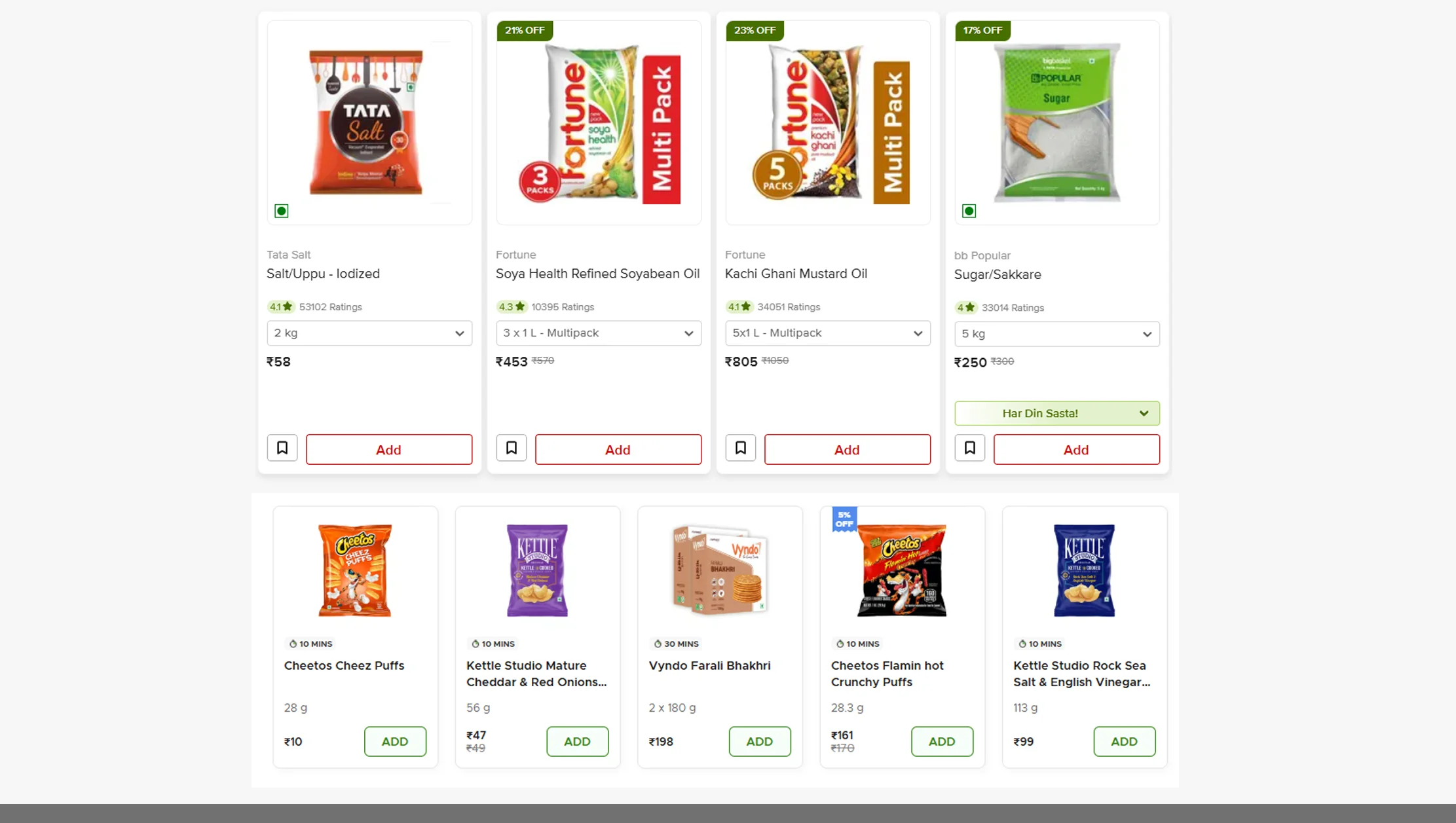
In today’s hyper-competitive grocery landscape, price remains a major factor influencing customer behavior. With platforms like Blinkit, Instacart, and BigBasket updating product prices dynamically based on demand, stock levels, and location, having access to real-time pricing data has become critical for retailers, aggregators, and even CPG brands.
Using techniques like Extract grocery prices from Blinkit, Instacart pricing data scraper, and BigBasket product price extraction, businesses can capture granular product-level pricing insights. These insights help in:
- Competitive benchmarking
- Dynamic pricing strategy
- Promotional planning
- Localized assortment optimization
Below are key benefits of grocery price scraping:
Real-Time Competitive Intelligence
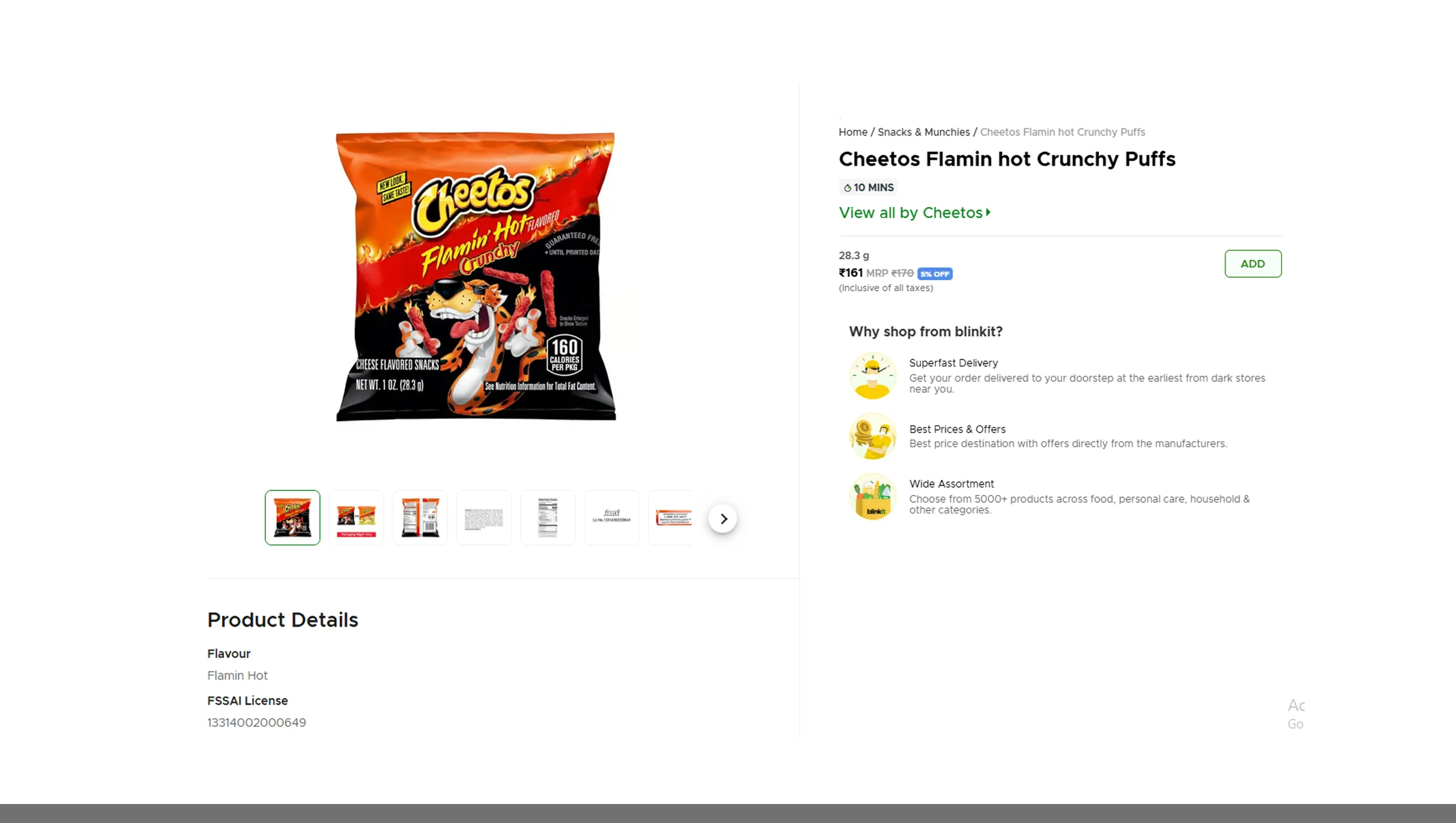
Scraping tools enable Blinkit supermarket data scraping, Instacart competitor price analysis, and BigBasket grocery data API integrations—providing real-time visibility into rivals’ pricing across categories.
Reduce Manual Work
Rather than relying on manual audits, scraping tools for Blinkit prices, Instacart product pricing scraper, and BigBasket data extraction services automate the data collection process, saving time and reducing human error.
Fuel Pricing Engines & BI Systems
Feed real-time pricing data into dashboards and AI models to enhance price sensitivity models, drive inventory decisions, and personalize offers based on customer behavior.
Online Grocery Price Scraping Trends (2020–2025)
| Year | Blinkit Products Tracked | Instacart Price Checks | BigBasket SKUs Monitored |
|---|---|---|---|
| 2020 | 25,000 | 80,000 | 30,000 |
| 2021 | 40,000 | 120,000 | 50,000 |
| 2022 | 65,000 | 200,000 | 80,000 |
| 2023 | 90,000 | 350,000 | 120,000 |
| 2024 | 130,000 | 500,000+ | 160,000 |
| 2025 | 180,000+ (est.) | 750,000+ (est.) | 220,000+ (est.) |
Estimates based on current scraping volumes and platform growth trends.
Whether you're a retailer aiming to outpace the competition or a startup planning your product-market strategy, leveraging Instacart data extraction services, BigBasket data extraction services, and Blinkit price monitoring tools can be the game-changer that propels your success.
Unlock smarter pricing, boost profits, and outpace competitors with real-time grocery data from Blinkit, Instacart, and BigBasket.
Get Started Now!Understanding Blinkit, Instacart, and BigBasket as Data Sources
As the online grocery space evolves rapidly, Blinkit, Instacart, and BigBasket have emerged as dominant players in their respective regions. Each offers unique pricing models and inventory structures, making them valuable sources for data-driven insights and competitive analysis.
Blinkit (India)
.webp)
Formerly known as Grofers, Blinkit focuses on ultra-fast 10–20-minute deliveries across major Indian metros. Its real-time, location-based pricing means prices in cities like Delhi often differ from those in Mumbai or Bengaluru.
- Local vendor integration enables hyperlocal SKU visibility.
- Dynamic product availability, seasonal pricing, and frequent updates make it ideal for Blinkit supermarket data scraping.
Blinkit Product Stats (2020–2025)
| Year | Cities Covered | Avg. SKUs per City | Daily Price Changes |
|---|---|---|---|
| 2020 | 12 | 8,000 | 2,000 |
| 2021 | 20 | 10,500 | 3,000 |
| 2022 | 28 | 12,000 | 4,500 |
| 2023 | 30+ | 14,000 | 6,000 |
| 2024 | 40+ | 16,500 | 8,000 |
| 2025* | 50+ (est.) | 20,000+ (est.) | 10,000+ (est.) |
Instacart (USA)
.webp)
Instacart aggregates inventory from retailers like Costco, Kroger, and Walmart. Pricing varies by store, ZIP code, and delivery urgency. It also includes promo codes and coupons.
- Ideal for Instacart competitor price analysis and dynamic pricing insights.
- Wide variability and discount logic make Instacart pricing data scraping highly valuable.
Instacart Coverage & Data Volume
| Year | Partner Stores | Avg. SKUs per Store | Discount Types Tracked |
|---|---|---|---|
| 2020 | 150 | 20,000 | 1,000 |
| 2021 | 250 | 25,000 | 2,000 |
| 2022 | 400 | 30,000 | 3,500 |
| 2023 | 500+ | 35,000 | 4,500 |
| 2024 | 600+ | 40,000 | 6,000 |
| 2025* | 700+ (est.) | 45,000+ (est.) | 7,500+ (est.) |
BigBasket (India)
.webp)
India’s earliest large-scale grocery app, BigBasket relies on central warehouses and city hubs. It features location-wise availability and private label brands with warehouse-driven pricing.
- Perfect for BigBasket product price extraction and private label tracking.
- Regional pricing and inventory logic enhance data accuracy.
BigBasket Metrics
| Year | Cities Served | Avg. SKUs | Private Label SKUs |
|---|---|---|---|
| 2020 | 15 | 18,000 | 1,200 |
| 2021 | 25 | 22,000 | 1,800 |
| 2022 | 35 | 26,000 | 2,500 |
| 2023 | 40+ | 30,000 | 3,200 |
| 2024 | 45+ | 33,000 | 4,000 |
| 2025* | 50+ (est.) | 36,000+ | 5,000+ (est.) |
Each of these platforms brings diverse datasets—making them excellent for scraping grocery prices, tracking promotions, regional preferences, and competitive pricing strategies.
Web Scraping for Grocery Pricing
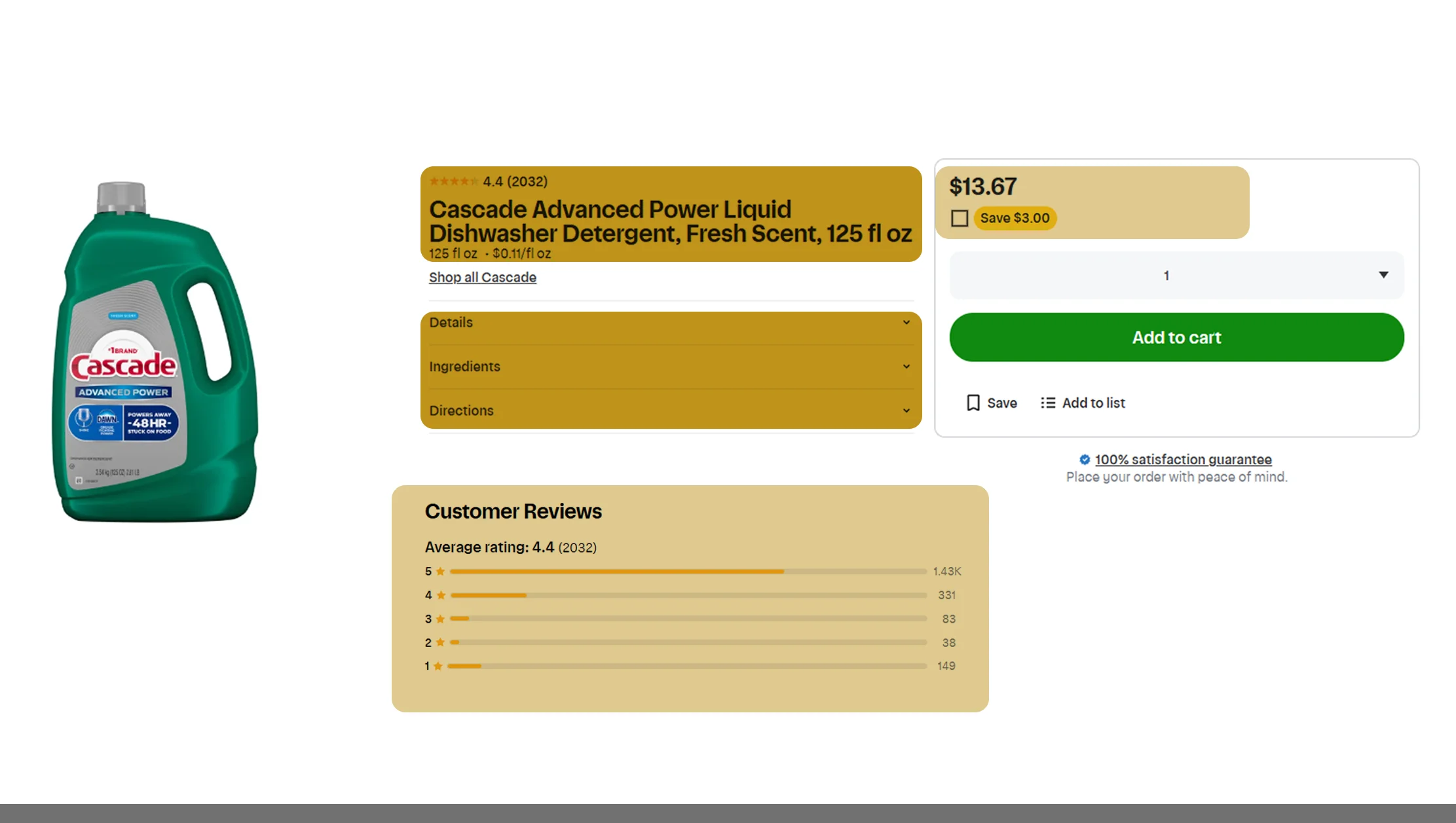
In the age of real-time retail intelligence, web scraping offers a powerful way to collect actionable data from top grocery platforms like Blinkit, Instacart, and BigBasket. These platforms continuously update prices, stock status, and offers — making them goldmines for businesses aiming to gain a competitive edge.
Scraping involves sending automated requests to websites and extracting relevant product-level information, such as:
- Product Name
- Brand
- Quantity/Weight
- Price (Regular & Discounted)
- In-stock/Out-of-stock status
- Location-specific price variations
Key Technologies Used in Grocery Price Scraping:
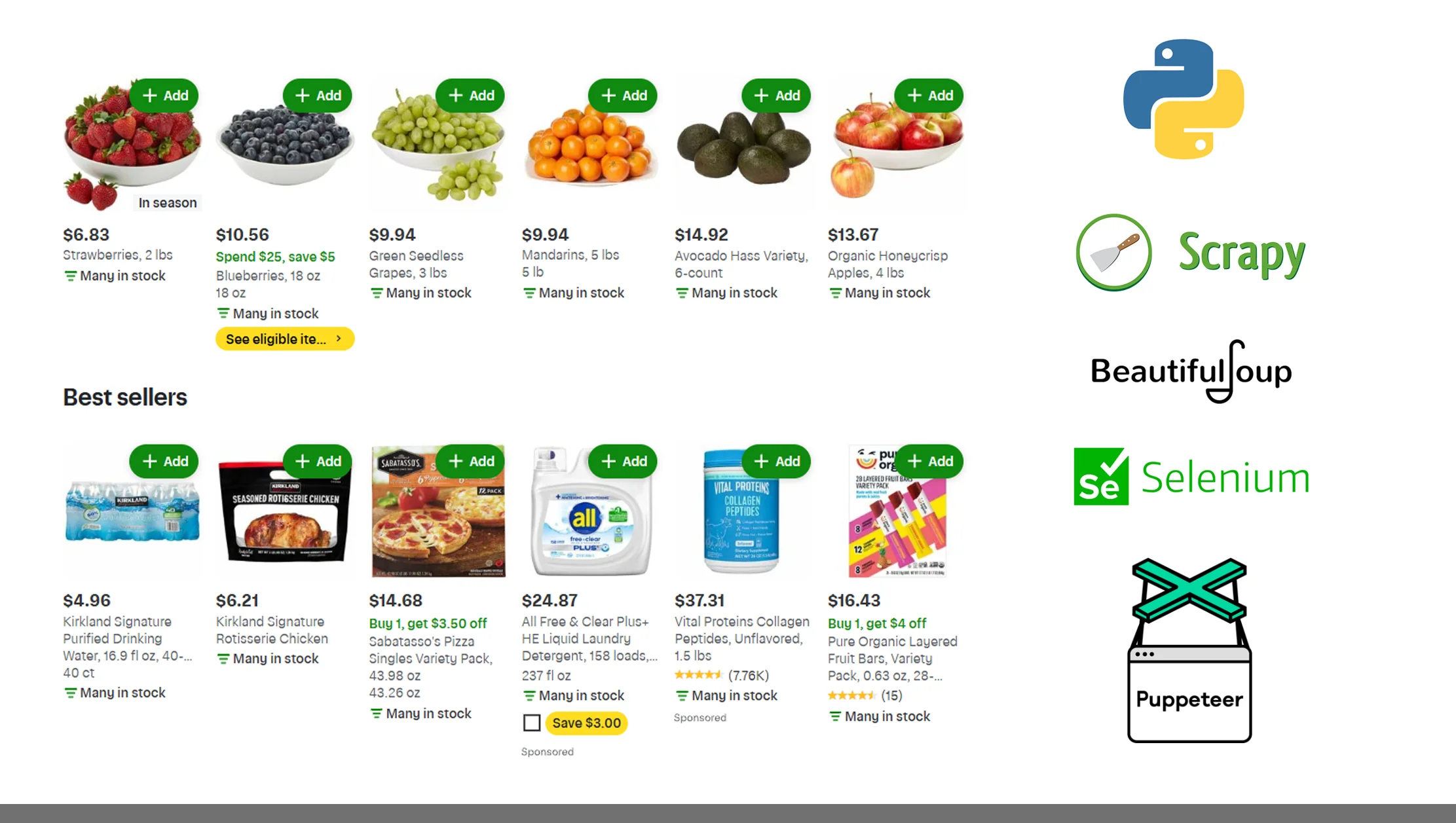
- Python: Most widely used scripting language
- BeautifulSoup: For parsing HTML content
- Selenium / Playwright: For JavaScript-heavy and dynamically loaded websites
- Scrapy: A scalable scraping framework for large datasets
- Puppeteer: For handling complex front-end rendering
- Proxy Rotators: To bypass geo-restrictions and IP bans
- OCR & Image Parsing: Useful for extracting prices embedded in visuals
What You’ll Need to Extract:
| Platform | Data Points |
|---|---|
| Blinkit | Product Name, MRP, Offer Price, Discount %, Store Location |
| Instacart | Store Name, Product Title, Quantity, Regular Price, Club Price, Delivery Fees |
| BigBasket | SKU Code, Product Name, Brand, Price, Offers, Stock Status, City |
Scraping Blinkit – Challenges & Solutions
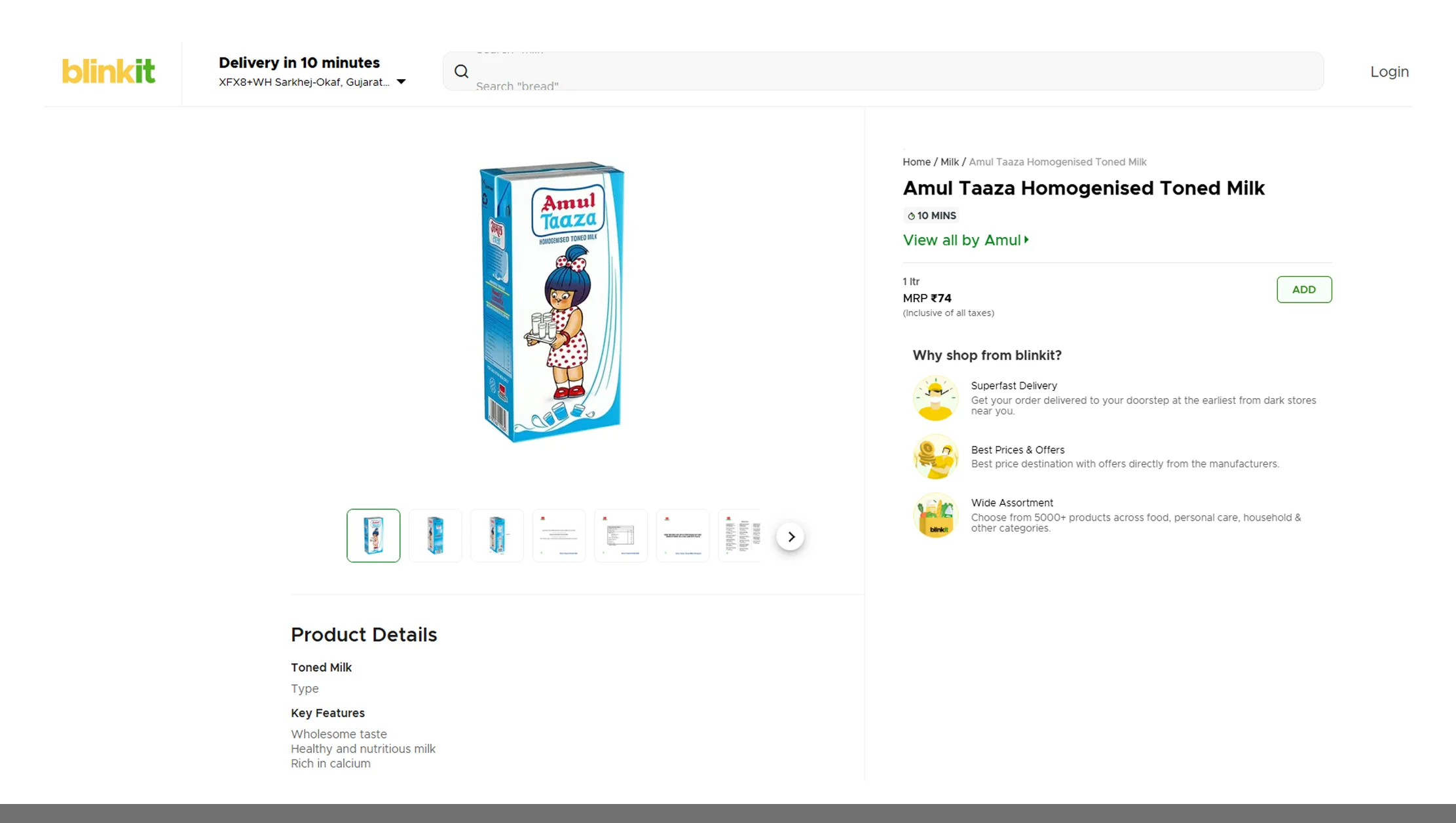
Blinkit grocery price scraping is more complex due to its tech architecture. It uses dynamic rendering, location-specific pricing, and lazy loading — making traditional scraping ineffective.
Key Observations:
- URLs vary with location (e.g., https://www.blinkit.com/location)
- Product details are dynamically loaded via JavaScript
- Prices change based on cart actions and delivery areas
Scraping Strategy for Blinkit:
- Use Selenium or Playwright to render JavaScript and navigate through location-based interfaces
- Select delivery cities programmatically (Delhi, Mumbai, Bengaluru) to capture regional pricing
- Store extracted SKU, price, and availability in a structured relational database for comparison over time
Whether you're looking for Instacart data extraction services, BigBasket product data scraping, or planning to scrape Blinkit grocery data, a solid tech stack and strategy are key to reliable and scalable price intelligence.
Sample Target Data:
{
"product": "Amul Milk 1L",
"mrp": "₹65",
"offer_price": "₹60",
"discount": "7.7%",
"location": "Mumbai",
"in_stock": true
}
Scraping Instacart - Store-Specific Data
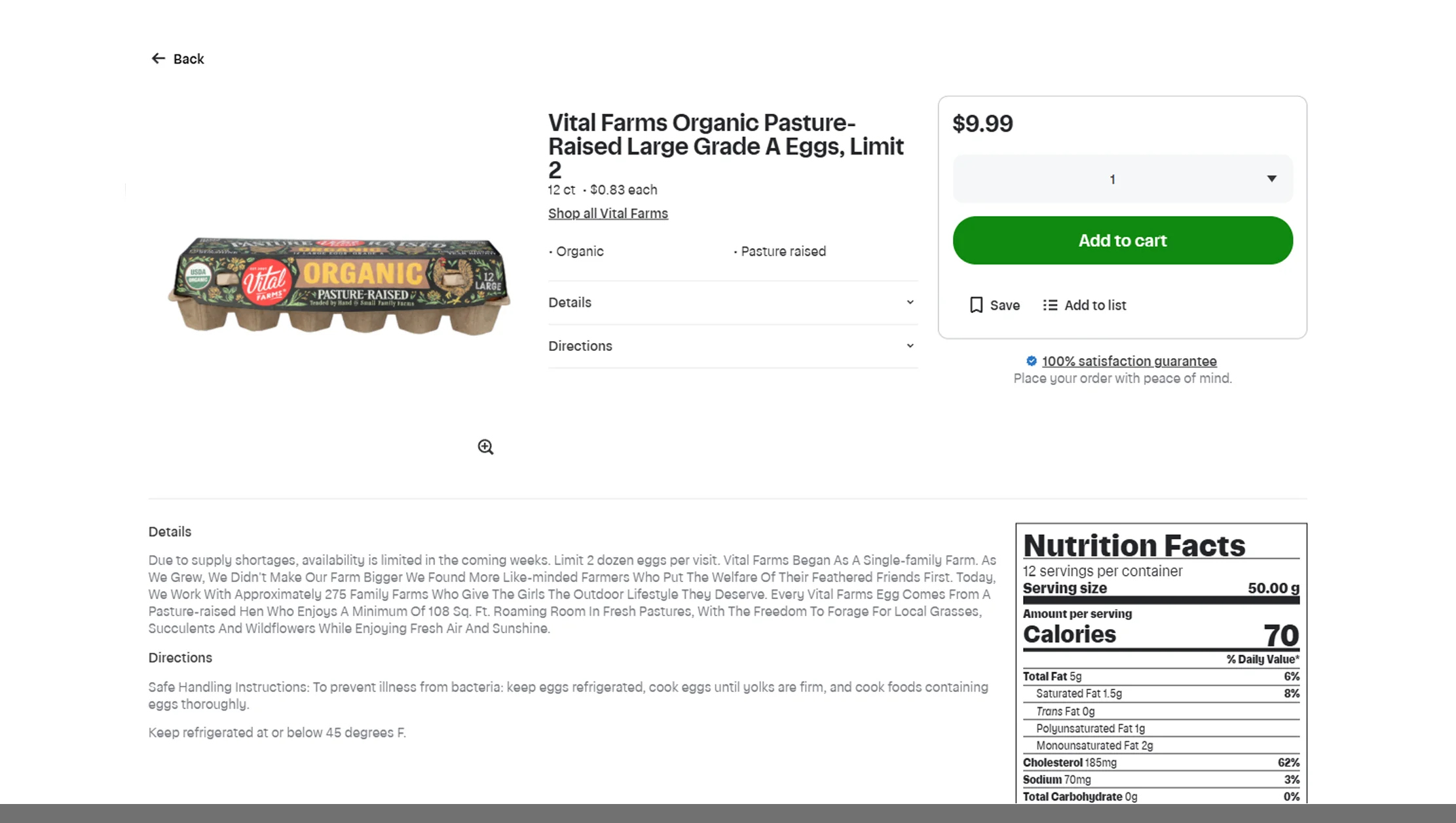
Scraping grocery data from Instacart is more complex compared to direct retailers like BigBasket or Blinkit. That’s because Instacart is an aggregator, not a traditional eCommerce store. It connects users with local retailers like Costco, Kroger, Safeway, and others — and pricing can vary significantly between these partners, even within the same city.
Here’s why scraping Instacart grocery data is a unique challenge:
- Instacart doesn’t own inventory – it pulls real-time data from partnered stores.
- Each store requires ZIP code selection for accurate availability and pricing.
- Many price values and product info are embedded within JavaScript objects, requiring dynamic content handling.
Key Tips for Accurate Instacart Data Extraction:
- Simulate a user session using Selenium or Playwright to select a specific store and ZIP code.
- Scrape structured data from embedded JavaScript or use tools like Puppeteer to inspect DOM-bound data.
- Be prepared for price variations based on delivery times, club memberships, and promotional offers.
For businesses needing Instacart data extraction services, it’s essential to capture store-specific pricing, delivery fees, and regional availability to support competitive analysis and localized pricing strategies.
Sample Scraped Record:
{
"store": "Costco",
"product": "Organic Eggs 12 ct",
"price": "$4.99",
"category": "Dairy",
"delivery_fees": "$3.99",
"zip": "94107"
}
Scraping BigBasket - Rich Product Catalog

BigBasket, one of India’s leading online grocery platforms, offers a well-structured and extensive product catalog, making it relatively easier to scrape than Blinkit or Instacart. However, the major challenge lies in rate-limiting — BigBasket aggressively throttles requests and can block IPs quickly if scraping patterns aren't managed carefully.
What to Watch:
- BigBasket uses structured HTML for most of its product listings, with clear CSS selectors for product name, price, brand, and quantity.
- Product URLs often follow consistent patterns like /pd/ or /product/, which makes link extraction easier.
- Their servers actively monitor traffic — so expect IP bans or CAPTCHA triggers without proper precautions.
Scraping Tips:
- Use Scrapy, a Python-based scraping framework, to efficiently crawl product pages with built-in retry and throttling support.
- Implement proxy rotation and custom user-agent headers to avoid detection and simulate genuine browsing behavior.
- Respect BigBasket’s rate limits and manage session cookies to maintain continuity during scraping.
- Utilize pagination logic to iterate through all product listings within each category, ensuring a complete scrape.
For successful BigBasket product data scraping, combining speed with stealth is key — especially when targeting real-time price, offer, and stock data for competitive analysis.
Harness the power of web scraping to track grocery prices, optimize strategies, and stay competitive in the online retail market.
Get Started Now!Tools & Platforms for Scalable Scraping
To extract high-volume, real-time grocery pricing data from platforms like Blinkit, Instacart, and BigBasket, you need more than just a script — you need a robust, scalable scraping stack. From open-source tools to enterprise-grade platforms, choosing the right technology is crucial for reliable, continuous data pipelines.
Open-Source Tools for Scraping at Scale
| Tool | Purpose |
|---|---|
| Scrapy | A powerful Python framework ideal for high-speed, structured web scraping |
| Playwright | A fast, modern headless browser for rendering JavaScript-heavy pages like Blinkit supermarket data scraping |
| Selenium Grid | Enables distributed scraping across multiple nodes or VMs |
| Tor Proxies | Provides IP anonymity and geo-rotation to avoid bans on sites like Instacart product pricing scraper |
| MongoDB / PostgreSQL | For storing and querying structured data scraped from platforms like BigBasket grocery data API |
These tools are ideal if you have an in-house dev team and need full control over your scraping architecture.
Cloud & SaaS-Based Scraping Platforms
| Platform | Use Case |
|---|---|
| Real Data API | Enterprise-grade solutions for Instacart pricing data scraper and BigBasket data extraction services |
| Mobile App Scraping | Extract product listings, discounts, and cart data from grocery apps like Blinkit |
| Food Data Scrape | Specializes in extracting grocery prices from Blinkit and food delivery platforms |
| Retail Scrape | Scrapes SKUs, pricing, availability, and ratings from eCommerce platforms with precision and speed |
These platforms offer automated scaling, rotating IPs, and headless browsers—ideal for businesses scraping thousands of SKUs daily across cities and stores.
When to Go Scalable?
If your use case involves:
- BigBasket product price extraction across regions
- Frequent Instacart competitor price analysis
- Real-time updates for BigBasket price monitoring tools
- Extracting Blinkit data for regional pricing strategy
then cloud scraping with automated scaling is the smart move.
For sustained accuracy, platforms like Real Data API ensure high availability and structured delivery formats — turning scraping tools for Blinkit prices and BigBasket data extraction services into revenue-driving engines for your grocery intelligence.
Legal & Ethical Considerations
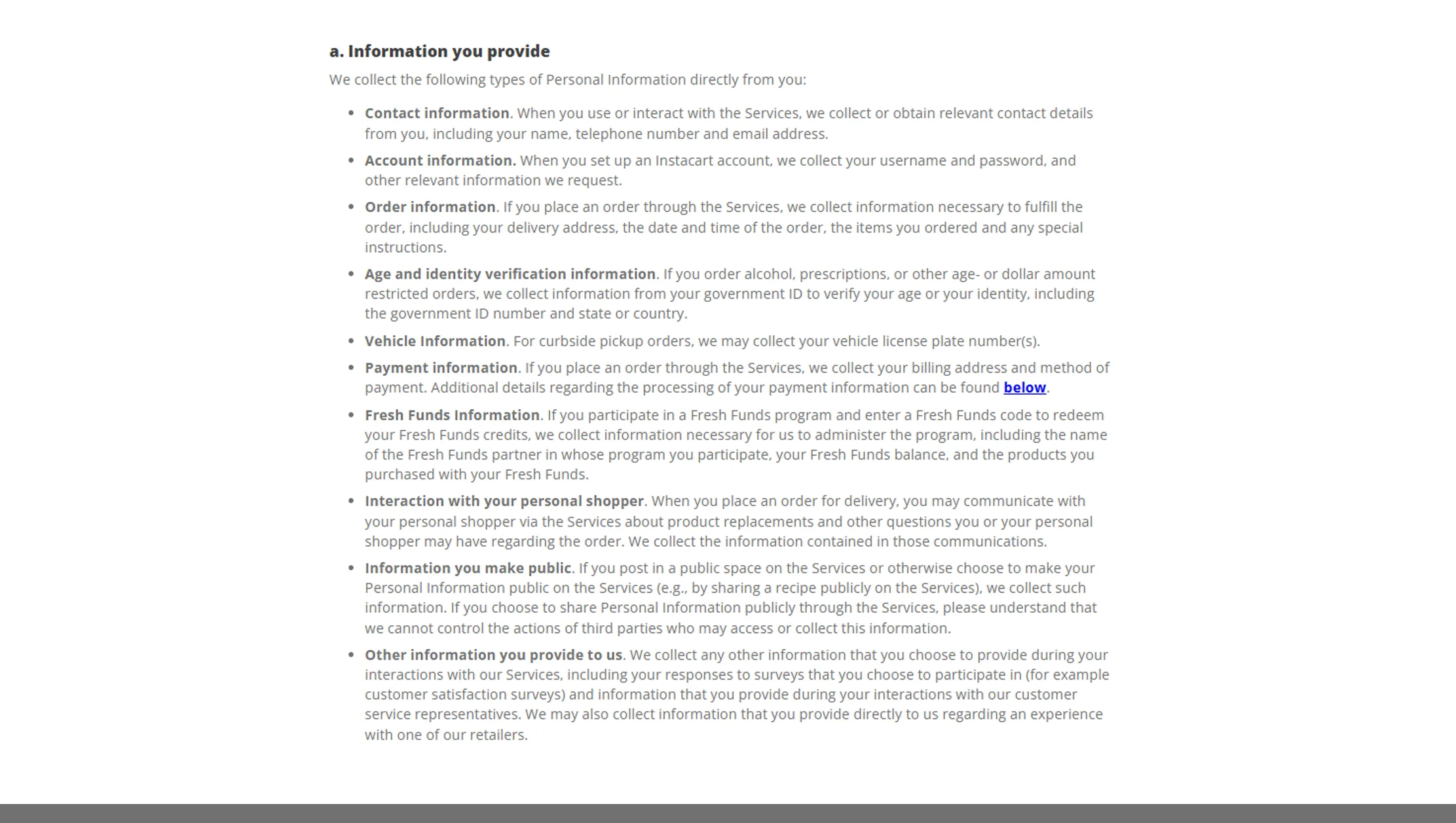
While web scraping offers significant advantages for competitive analysis, pricing intelligence, and market research, it's crucial to navigate the legal and ethical boundaries to avoid compliance risks.
Legal Factors
- Terms of Service (ToS): Most platforms like Blinkit, Instacart, and BigBasket prohibit unauthorized automated access. Violating these terms can lead to IP bans or legal notices.
- Copyright & IP Laws: While scraping publicly available data isn’t inherently illegal, copying proprietary formats, logos, or brand content can infringe intellectual property rights.
- Computer Misuse Laws: In jurisdictions like the U.S., scraping without authorization may breach laws like the Computer Fraud and Abuse Act (CFAA).
Ethical Considerations
- Respect Rate Limits: Avoid overloading servers or disrupting service availability.
- Transparency & Fair Use: Use data for legitimate business insights, not to clone or harm competitors.
- Data Privacy Compliance: Do not scrape personally identifiable information (PII) unless explicitly permitted, especially under laws like GDPR or India’s DPDP Act.
For lawful scraping, always opt for compliance-friendly scraping tools, honor robots.txt where applicable, and consider official APIs when available. Responsible data collection helps build trustworthy, long-term intelligence systems.
How Businesses Use Scraped Grocery Price Data?
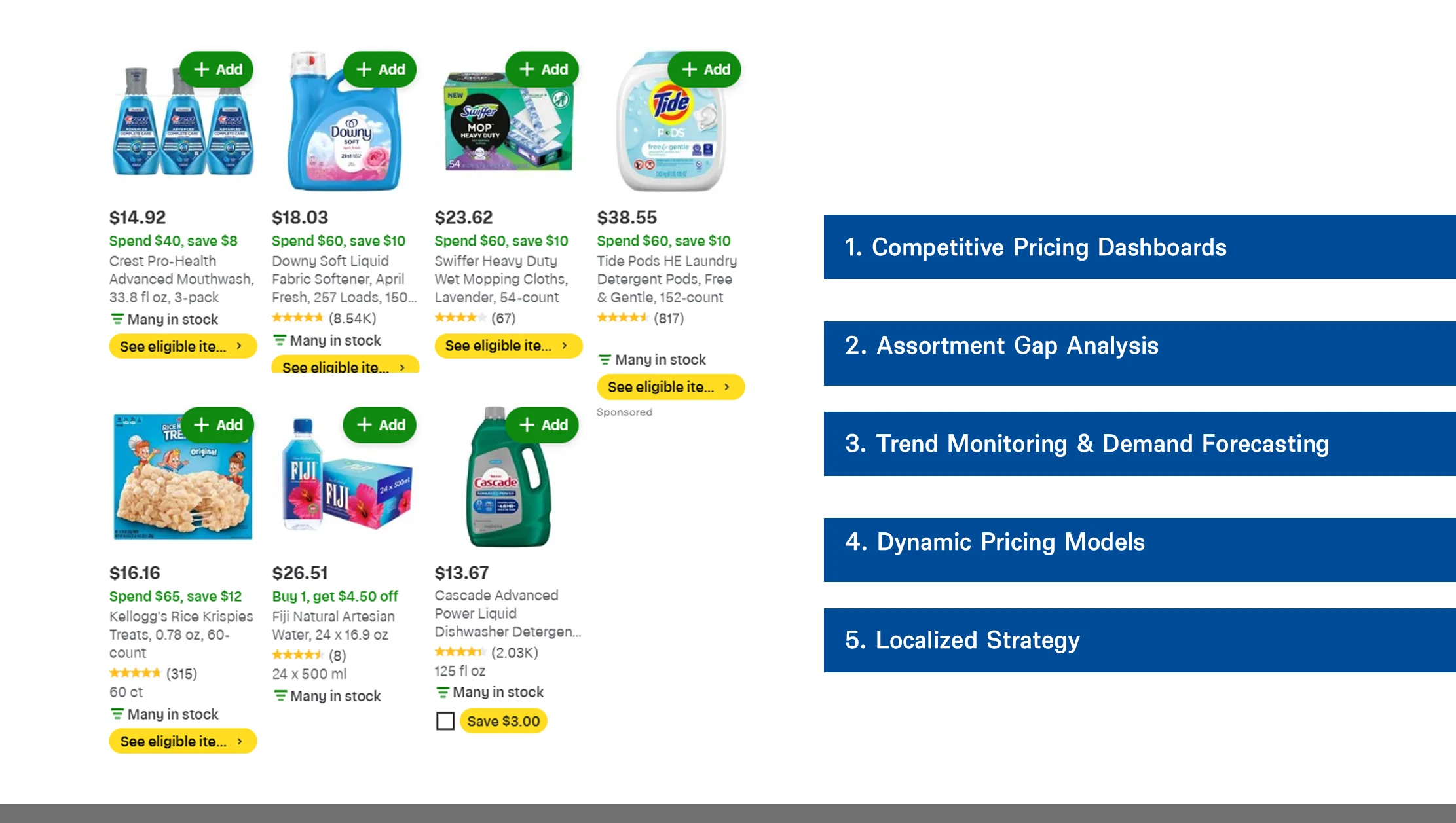
In today’s dynamic retail landscape, grocery businesses, D2C brands, and FMCG giants are increasingly turning to data scraping to gain real-time market insights. Platforms like Blinkit, Instacart, and BigBasket offer rich pricing data — and when scraped ethically, this data becomes a goldmine for strategic decision-making.
1. Competitive Pricing Dashboards
Using Blinkit grocery price scraping and Instacart data extraction services, businesses build real-time dashboards to compare SKU prices across platforms. These dashboards help teams dynamically benchmark prices, optimize margins, and respond quickly to competitor price shifts.
2. Assortment Gap Analysis
By leveraging tools that scrape Blinkit grocery data and BigBasket product data scraping, brands analyze product availability gaps across platforms. For example, if a competitor sells an exclusive flavor or brand on Blinkit but not on BigBasket, businesses can introduce unique assortments to fill that void.
3. Trend Monitoring & Demand Forecasting
Through Instacart grocery data scraping and BigBasket price monitoring tools, companies monitor which categories (e.g., organic produce, cleaning supplies) see frequent discounts. These trends are vital for demand forecasting, inventory planning, and seasonal campaigns.
4. Dynamic Pricing Models
Retailers and D2C brands use Blinkit supermarket data scraping and Instacart product pricing scraper to feed data into dynamic pricing engines. These tools enable automated repricing strategies based on competitors’ latest offers, helping brands stay agile and competitive.
5. Localized Strategy
With the help of BigBasket grocery data API and tools that scrape across cities like Mumbai, Delhi, San Francisco, and LA, businesses develop geo-targeted promotions. This is especially useful for brands selling in multiple zones with varying consumer behaviors.
By deploying advanced web scraping technologies, companies unlock actionable insights from platforms like Blinkit, Instacart, and BigBasket — turning raw data into pricing power and market precision.
Leverage scraped grocery price data to optimize pricing, forecast demand, analyze competition, and make data-driven decisions for retail success.
Get Started Now!Real-World Insights From Scraped Data

With millions of rows extracted using Blinkit grocery price scraping, Instacart data extraction services, and BigBasket product data scraping, businesses can unlock rich, actionable insights. Here's how real-world grocery data translates into smart retail decisions:
1. Product Category Insights
- Organic foods on platforms like BigBasket and Instacart show frequent discounts due to shorter shelf lives.
- Dairy product pricing is highly stable — often regulated and inelastic.
- Fruits and vegetables show dynamic pricing daily, especially on Blinkit, due to local sourcing.
2. Cart Behavior Patterns
- Bulk packaging (2L oils, 5Kg rice) sees deeper discounts to push high-volume sales.
- Premium brands offer minimal discounts but occupy top placements in app UI, indicating better shelf visibility.
3. Time-Based Trends
- Discounts peak on weekends and Indian festivals (Diwali, Holi) for BigBasket and Blinkit.
- Flash sales increase near month-end, especially on personal care and packaged foods.
4. Store-Level Strategies
- On Instacart, Costco generally provides the lowest price per unit, but adds higher delivery/service charges.
- Blinkit positions pricing around urgency and speed, charging slightly more for instant delivery items.
5. Visualizing the Data
Use scraping results from BigBasket data extraction services and scraping tools for Blinkit prices in BI dashboards:
- Tableau/Power BI: Create pricing heatmaps across cities.
- Plotly/Seaborn: Track price fluctuations by product category.
- Geo Charts: Highlight pricing variance in cities like Delhi, Mumbai, LA, and San Francisco.
Example Charts:
- “Top 10 Discounted Categories per City”
- “Blinkit vs BigBasket: Price Comparison for Top 100 SKUs”
- “Instacart Store Comparison: Kroger vs Costco”
Turn scraped data into a strategic powerhouse — from optimizing discounts to designing regional promotions.
Why Choose Real Data API?
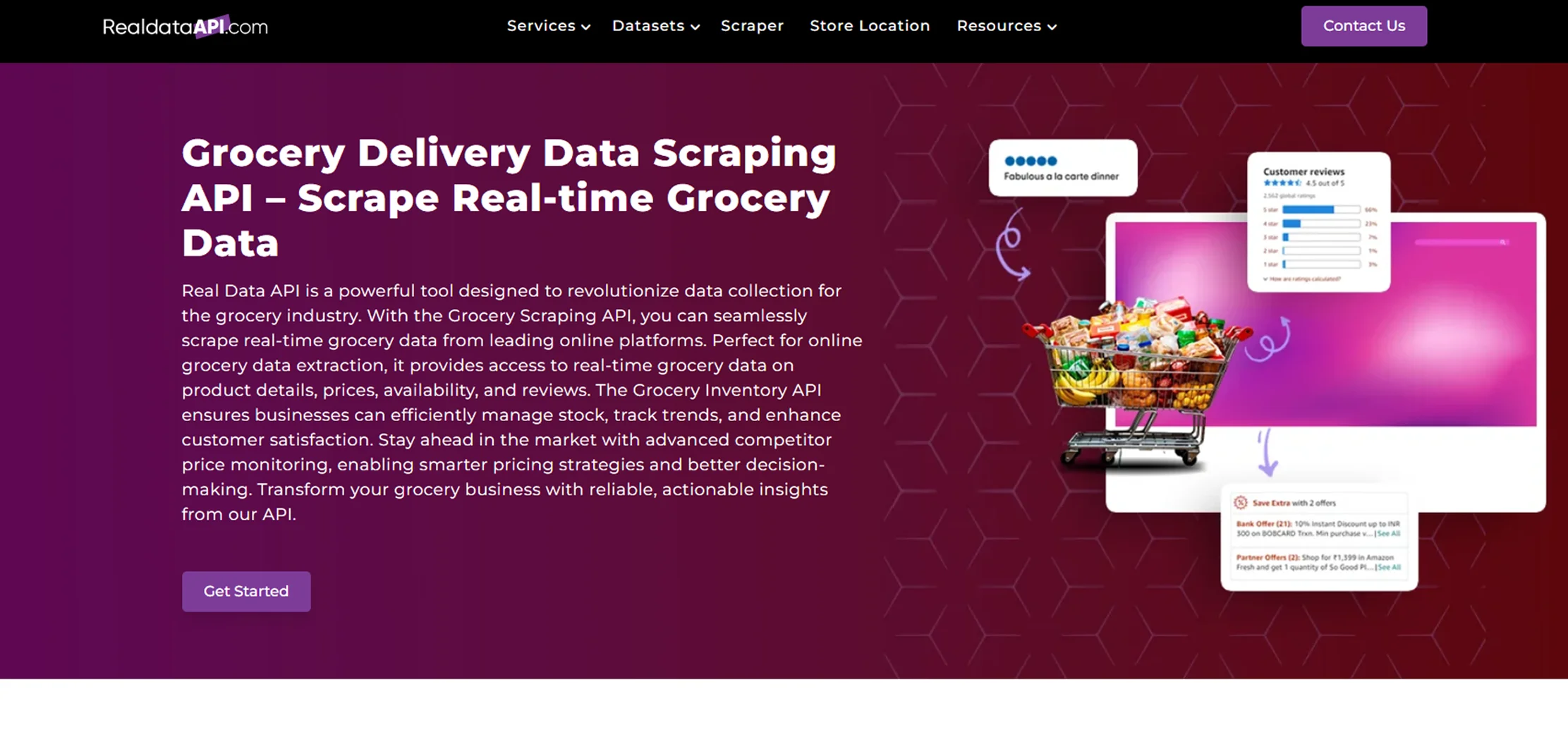
Real Data API is your go-to solution for scalable and accurate data extraction, built specifically for high-performance use cases like price monitoring and competitive analysis. Whether you're looking to scrape Blinkit grocery data, extract store-level insights from Instacart, or access structured datasets from BigBasket, Real Data API delivers real-time, geo-specific data directly into your systems.
We specialize in advanced tools such as Blinkit supermarket data scraping, Instacart competitor price analysis, and BigBasket grocery data API integration. Our platform supports automated scheduling, seamless API integration, and custom formatting, helping you turn scraped data into actionable business intelligence. With our compliance-ready, high-speed scraping architecture, you can stay ahead in the dynamic grocery retail landscape.
Conclusion
Scraping grocery prices from Blinkit, Instacart, and BigBasket is more than just collecting numbers — it’s about unlocking a strategic advantage in a competitive retail environment. Whether you're a data analyst, grocery chain, or retail tech startup, this data fuels smarter decisions. From enhancing your competitive pricing strategy to enabling accurate demand forecasting and minimizing overstock or wastage, the insights gained can redefine how you serve your customers. At Real Data API, we specialize in Blinkit grocery price scraping, Instacart data extraction services, and BigBasket product data scraping. Our end-to-end solutions include competitor price monitoring, brand and product-level analysis, location-specific price comparisons, and seamless dashboard integrations. Let’s help you gain the pricing edge.














